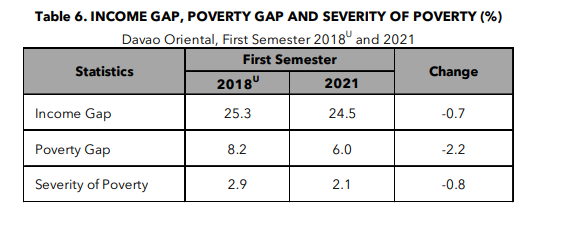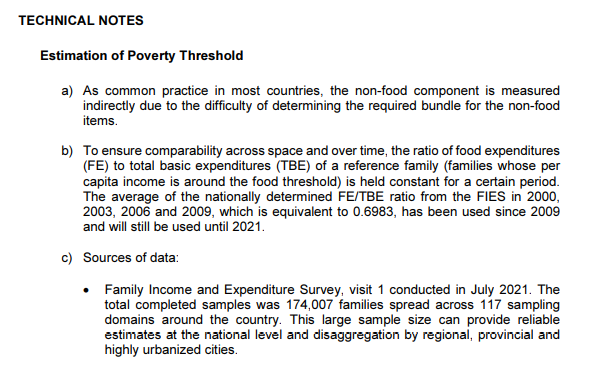PhP11,490 needed to stay out of poverty
In the first semester of 2021, a family of five in Davao Oriental needed no less than PhP7,991, on average, to meet the family’s basic food needs for a month or PhP266 per day. This amount is the food threshold which is 8.68 percent or PhP638 higher than the PhP7,353 food threshold recorded in 2018. On the other hand, no less than PhP11,490, on average, was needed to meet both basic food and non-food needs of a family of five in a month or PhP383 per day. This amount is the poverty threshold. This poverty threshold is 9.12 percent or PhP960 higher than the poverty thresholds from the first semester of 2018 which was PhP10,530. (Table 1)

Food threshold is the minimum income required to meet the basic food needs, satisfying the nutritional requirements set by the Food and Nutrition Research Institute (FNRI) to ensure that one remains economically and socially productive. It is used to measure extreme subsistence of poverty.
Poverty threshold, on the other hand, is the minimum income required to meet the basic food and non-food needs such as clothing, fuel, light and water, housing, rental of occupied dwelling units, transportation and communication, health and education expenses, non-durable furnishing, household operations and personal care and effects.
Poor families in Davao Oriental were estimated at 36,274
Poverty incidence among families is defined as the proportion of families whose income is below the poverty line to the total number of families. Poverty incidence among families in Davao Oriental during the first semester of 2021 was estimated at 24.5 percent. This means that 36,274 of the total number of families in the province have a monthly income below the poverty threshold of PhP11,490. This was estimated at 32.6 percent in the same period in 2018. The number of poor families in the province was at 46,788 in 2018. (Table 2)

On the other hand, poverty incidence among individuals is referred to as the proportion of the population living below the poverty line to the total population.
The poverty incidence among individuals in Davao Oriental in the first semester of 2021 was estimated at 32.7 percent. This means that 199,017 of the total population of the province have a income below the per capita poverty threshold of PhP13,788. During the same period in 2018, poverty incidence among population in Davao Oriental was recorded at 42.0 percent. (Table 3)

Food poor families decreased at 8.7 percent
Subsistence incidence among families is the proportion of Filipino families whose incomes fall below the food threshold. The subsistence incidence among families in the province was estimated at 8.7 percent in the first semester of 2021. This means that 12,860 families in the province have a monthly income below the food threshold of PhP7,991. In the same period in 2018, the proportion of families who were food poor was higher at 11.5 percent or 16,529 families. (Table 4)

Subsistence incidence among individuals, on the other hand, refers to the proportion of Filipinos whose incomes fall below the food threshold.
Among individuals in the province, subsistence was estimated at 12.6 percent in the first semester of 2021. This means that 76,412 of the total population of the province have an income below the per capita food threshold of PhP9,589 for the first semester of 2021. In the same period of 2018, 16.6 percent or 54,754 of the total population were food poor. (Table 5)

Income Gap, Poverty Gap and Severity of Poverty
The income gap measures the average income required by the poor in order to get out of poverty, expressed relative to the poverty threshold. The poverty gap refers to the income shortfall (expressed in proportion to the poverty threshold) of families with income below the poverty threshold, divided by the total number of families. The severity of poverty is the total of the squared income shortfall (expressed in proportion to the poverty threshold) of families with income below the poverty threshold, divided by the total number of families. This is a poverty measure that is sensitive to income distribution among the poor.
In the first semester of 2021, on average, incomes of poor families were short by 24.5 percent of the poverty threshold. This implies that a poor family with five members needs an additional monthly income of about PhP2,815 to move out of poverty in 2021. This can serve as useful reference especially in determining the necessary budget to eradicate poverty in the province.
During the same period in 2018, this was estimated at 25.3 percent or an additional income of PhP2,664.
On the other hand, the poverty gap in the province was estimated at 6.0 percent in the first semester of 2021. During the same period in 2018, the poverty gap was 8.2 percent. This means that each family has income shortfall of 6.0 percent of the poverty threshold to eliminate poverty. This can also be translated to a total cash transfer of PhP689 for a family of five in a month, on average, to move everyone out of poverty.
The income gap, poverty gap and severity of poverty improved from the first semester of 2018 to the same period in 2021. The income gap, poverty gap and severity of poverty decreased by -0.7, -2.2, and 0.8 percentage points, respectively.

Approved for Release:
ROGELIO T. LEBRIA
Chief Statistical Specialist
TECHNICAL NOTES



